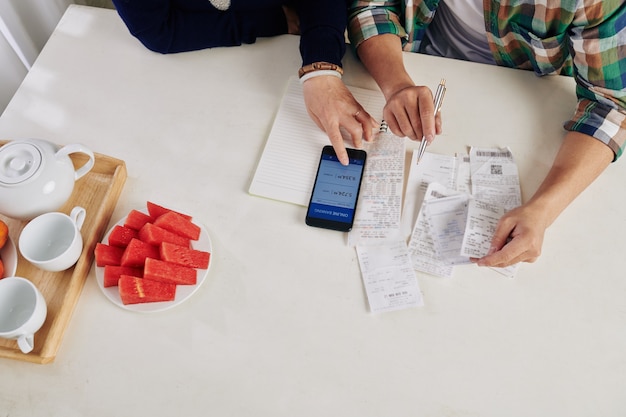The Ultimate Guide to Tracking Your Spending: Compare Money Management Tools

The Ultimate Guide to Tracking Your Spending: Money Management Tools Compared offers an in-depth analysis of various tools and techniques available to effectively monitor and manage your expenses, helping you to achieve financial clarity and improve your overall money management skills.
Are you looking to get a better handle on your finances? The Ultimate Guide to Tracking Your Spending: Money Management Tools Compared will provide you with the knowledge and resources to effectively monitor your expenses and take control of your financial well-being.
Why Tracking Your Spending Matters
Understanding where your money goes is the first step towards financial success. Without tracking, it’s easy to overspend and miss opportunities to save.
Tracking your spending isn’t just about cutting back; it’s about making informed decisions about your money.
Benefits of Monitoring Your Expenses
Keeping a close eye on your expenses can lead to significant improvements in your financial health. Here are some key advantages:
- Identify Spending Patterns: Discover where your money is really going each month.
- Create Realistic Budgets: Based on actual data, not just guesswork.
- Achieve Financial Goals: Save for a down payment, pay off debt, or invest wisely.
- Reduce Financial Stress: Gain control over your finances and feel more secure.
Tracking also makes you more mindful of your spending habits. You’re more likely to think twice before making impulse purchases when you know you’re keeping a record.
Moreover, it provides a factual basis for adjusting your financial strategies. Instead of vague feelings about overspending, you have concrete data to work with.

Lastly, tracking helps you align your spending with your values. You’ll be able to see if your money is actually going towards the things that are most important to you.
Manual Spending Tracking Methods
Before the advent of apps and software, manual methods were the go-to options for tracking expenses. While they might seem old-fashioned, they can still be effective.
These methods often involve more discipline and attention to detail, which can be beneficial for some.
Spreadsheet Tracking
Using a spreadsheet program like Microsoft Excel or Google Sheets allows you to create custom expense trackers. Here’s how:
- Create Categories: List common expense categories such as housing, food, transportation, and entertainment.
- Record Transactions: Enter each transaction manually, noting the date, category, and amount.
- Summarize Data: Use formulas to calculate totals and identify areas where you’re overspending.
Spreadsheets provide flexibility and allow for detailed customization, but they require consistent manual entry.
Many find this approach more engaging as it forces you to confront your spending habits regularly.
Notebook and Pen
The traditional method of tracking expenses with a notebook and pen is simple and requires no technology. Keep a small notebook with you and record every purchase you make.
- Immediate Recording: Write down expenses as soon as they occur to prevent forgetting.
- Categorize Later: Take some time each week to categorize your expenses.
- Review Regularly: Look over your notes to identify spending patterns and areas for improvement.
This method is straightforward and can be therapeutic for some, but it may not be as efficient for those who prefer digital tools.
It also helps to keep receipts for a more accurate record, especially for larger expenses.

Manual tracking methods offer a hands-on approach to money management, allowing for greater awareness of spending habits and financial patterns.
Digital Money Management Tools
In today’s digital age, numerous tools are available to help you track your spending more efficiently. These tools range from budgeting apps to comprehensive financial software.
Often, these digital solutions offer real-time tracking, automated categorization, and insightful reports.
Budgeting Apps
Budgeting apps are designed to help you create and stick to a budget. Popular options include:
- Mint: A free app that connects to your bank accounts and automatically categorizes your transactions.
- YNAB (You Need A Budget): A subscription-based app that focuses on giving every dollar a job.
- Personal Capital: A free app that offers investment tracking and retirement planning tools in addition to budgeting features.
These apps provide a user-friendly interface and often include goal-setting features.
They can also send alerts when you’re nearing your budget limits.
Expense Tracking Apps
Expense tracking apps are specifically designed to record and analyze your expenses. Some popular choices include:
- Expensify: Ideal for business expenses, it also tracks personal finances.
- PocketGuard: Helps you track spending and shows how much you can safely spend each day.
- Spendee: Offers a visual and intuitive interface for managing your finances.
With these apps, you can easily scan receipts, categorize transactions, and generate detailed reports.
They are great for those who want a clear picture of where their money goes each month.
Digital tools make tracking expenses more accessible and convenient, offering a range of features to suit various financial needs and preferences.
Choosing the Right Tool for You
Selecting the best money management tool depends on your specific needs and preferences. Consider these factors when making your choice:
A tool that fits your lifestyle and financial goals will be more effective in the long run.
Consider Your Needs
Identify what you want to achieve with your spending tracker. Are you trying to create a budget, save for a specific goal, or simply understand where your money goes?
Different tools offer varying features, so align your choice with your objectives.
- Budgeting: Opt for apps like Mint or YNAB.
- Expense Tracking: Consider Expensify or Spendee.
- Investment Tracking: Personal Capital might be the right choice.
Answering these questions will help narrow down your options.
For example, if you have investments, a tool that aggregates all your financial information in one place might be ideal.
Evaluate Ease of Use
The tool you choose should be user-friendly and easy to navigate. A complicated interface can discourage consistent use.
Look for apps or software with intuitive dashboards and straightforward features.
- Mobile Access: Essential for on-the-go tracking.
- Syncing Capabilities: Automatically syncs with your bank accounts.
- Customization: Allows you to tailor categories and reports to your needs.
Taking the time to explore different options will ensure you find a tool that feels right.
Consider trying out free trials or demo versions before committing to a subscription.
Selecting the right money management tool is crucial for effective spending tracking and achieving long-term financial goals.
Tips for Effective Spending Tracking
Tracking your spending is only effective if done consistently and accurately. Here are some tips to ensure success:
Consistency and attention to detail are key to accurate and insightful financial tracking.
Set Clear Financial Goals
Having specific, measurable, achievable, relevant, and time-bound (SMART) goals will motivate you to track your spending more diligently.
Define what you want to achieve with your money management efforts.
- Save for a Vacation: Determine how much you need and by when.
- Pay Off Debt: Set a timeline and track your progress.
- Build an Emergency Fund: Aim for 3-6 months of living expenses.
Understanding your “why” will make the process more meaningful.
Visualizing your goals can also provide extra motivation.
Categorize Expenses Accurately
Accurate categorization is crucial for understanding your spending patterns. Be specific and consistent with your categories.
Use the same categories each month to allow for meaningful comparisons.
- Food: Separate groceries from dining out.
- Transportation: Distinguish between gas, public transit, and car maintenance.
- Entertainment: Differentiate between movies, concerts, and hobbies.
Regularly review your categories and adjust as needed.
Clear categorization allows you to identify specific areas where you can cut back.
Overcoming Common Challenges
Tracking your spending can be challenging, but it’s essential to address these obstacles to maintain consistency and accuracy.
By anticipating and addressing these hurdles, you can improve your spending tracking habits and achieve your financial goals.
Dealing with Irregular Income
If you have irregular income, such as freelance work, it can be difficult to budget and track your spending. Here’s how to manage it:
Planning and adaptability are key to managing finances when income fluctuates.
- Track Income and Expenses: Monitor both your income and expenses closely.
- Create a Buffer: Build a savings buffer to cover months with lower income.
- Prioritize Needs: Focus on covering essential expenses first.
Having a clear picture of your cash flow will help you maintain stability.
Consider using budgeting apps that allow for flexible budgeting based on variable income.
Staying Consistent
Consistency is key to successful spending tracking. Here are some strategies to stay on track:
Making it a habit is essential for long-term success.
- Set Reminders: Use calendar alerts to remind you to track your expenses regularly.
- Automate: Use apps that automatically track and categorize transactions.
- Review Regularly: Schedule time each week to review your progress.
Turning it into a routine will help you maintain momentum.
Reward yourself for sticking to your tracking schedule to stay motivated.
| Key Point | Brief Description |
|---|---|
| 💰 Set Financial Goals | Define SMART goals to stay motivated and focused. |
| 📊 Track Expenses Regularly | Monitor your spending daily or weekly for accurate insights. |
| 📱 Choose Right Tools | Select apps or spreadsheets fitting your needs. |
| ✅ Accurate Categorization | Clearly classify expenses for better understanding. |
Frequently Asked Questions (FAQ)
▼
Tracking your spending helps you understand where your money is going, identify areas where you can save, and make informed financial decisions to achieve your goals.
▼
Budgeting apps offer automated tracking, expense categorization, and real-time insights. They make it easier to create and stick to a budget, allowing for better financial control.
▼
Consider your needs, financial goals, and preferred method. Look for tools that are user-friendly, offer the features you need, and fit seamlessly into your daily routine for best results.
▼
If you have irregular income, track your income and expenses closely, create a financial buffer for low-income months, and prioritize essential expenses. Use budgeting apps that offer flexible tools.
▼
Set reminders, automate tracking where possible, regularly review your progress, and reward yourself for staying on track to make it a sustainable habit for better financial management.
Conclusion
Tracking your spending is a crucial step towards financial well-being. By understanding where your money goes and utilizing the right tools, you can gain control of your finances and achieve your long-term financial goals.





